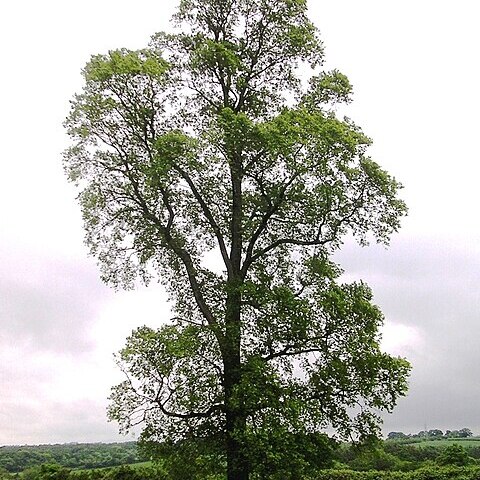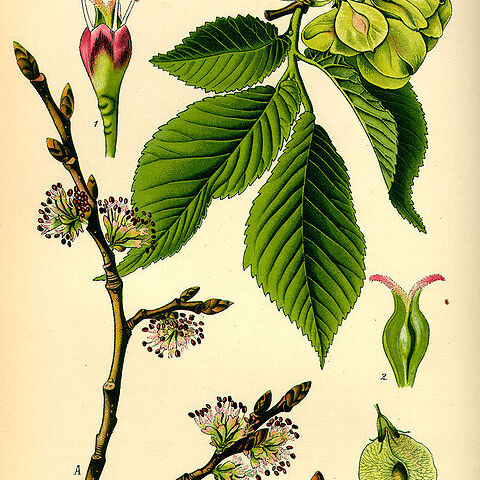Deciduous or semideciduous trees or shrubs. Innovations densely set with greyish to brownish simple hairs, glabrescent. Buds ovoid-conical or obovoid-globose, scales imbricate, hard and tough, glabrous. Stipules extrapetiolar, caducous. Leaves pinnately nerved, variously serrate to crenate, thin-to thick-coriaceous and rigid, glabrous or variously sparsely hairy at least beneath. Flowers but of two kinds, one functionally ♂ and the other functionally ♀, variously stalked and spirally arranged in fascicles of 3-15 on short lateral shoots. Perianth mostly campanulate, variously 4-8-lobed. Anthers glabrous, reniform, extrorse. Ovary compressed, sometimes stipitate; style short. Ovule 1, anatropous to amphitropous. Fruit a dry and compressed nutlet surrounded by a membranous reticulate-venose wing. Seed: endosperm absent, embryo straight with planoconvex cotyledons. Germination epigeal.
Trees, less often shrubs , to 35 m; crowns variable. Bark gray, brown, or olive to reddish, tan, or orange, deeply furrowed, sometimes with plates (smooth when young in Ulmus glabra ). Branches unarmed, slender to stout, some with corky wings; twigs glabrous to pubescent. Leaves sometimes tardily deciduous; stipules falling early. Leaf blade ovate to obovate or elliptic, base usually oblique, sometimes cordate or rounded to cuneate, margins serrate to doubly serrate; venation pinnate. Inflorescences fascicles, racemes, or cymes, pedunculate or subsessile, subtended by 2 bracts. Flowers on branches of previous season, appearing in spring before leaves or in fall, bisexual, pedicellate or sessile; calyx 3-9-lobed; stamens 3-9; styles persistent, deeply 2-lobed. Fruits samaras, usually flattened, membranously winged. x = 14.
Trees, deciduous or semideciduous, usually developing suckers; leaves of suckers frequently different from adult leaves. Leaves alternate, pinnately veined, serrate or crenate, usually oblique at base; stipules extrapetiolar, caducous. Inflorescence of 3–15 flowers in clusters or cymes, produced before the leaves on short lateral shoots. Flowers bisexual, sometimes functionally unisexual. Perianth 4–8-lobed. Stamens 5 or 6, usually exserted; anthers reniform, extrorse. Ovary compressed, sometimes stipitate; style short; ovule 1. Fruit a dry flattened winged nutlet or samara. Seeds with straight embryo; endosperm absent.
Bisexual shrubs or trees, the branches often flexuose. Leaves alternate, dis-tichous, inequilateral, serrate; stipules lateral. Inflorescence racemose or fasciculate, borne axillary on last year's growth. Flowers bisexual; sepals 4-8, more or less connate at the base; stamens as many as and opposite the calyx lobes, the anther dehiscence extrorse; ovary sessile or stipitate, 2-carpellate, 1-locular, compressed, the styles 2, often introrsely recurved, persistent. Fruit more or less samaroid, dry; seed flat; embryo straight with generally flat cotyledons; exendospermous.
Fls perfect, in short racemes or fascicles; cal campanulate, 4–9-lobed or cleft; anthers extrorse; styles short; fr a flat, 1-seeded samara, usually shortly stipitate and often surmounted by the persistent and sometimes enlarged styles; embryo straight; trees with pinnately veined, inequilateral, usually doubly serrate lvs; the small fls appear from buds resembling but a little larger than the lf-buds. 20, mainly N. Hemisphere. Three cult. Old-World spp. that occasionally escape are included in the key but not described.
Deciduous trees, usually suckering. Bark fissured. Lvs alternate, ± asymmetric at base, serrate. Fls ☿, protandrous, usually appearing before the lvs. Perianth usually 4-5-merous. Anthers reddish; ovule 1-locular. Fr. a samara, winged all round but the wing emarginate at apex. Endosperm 0.


